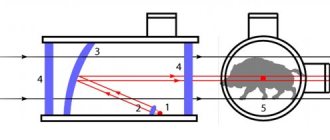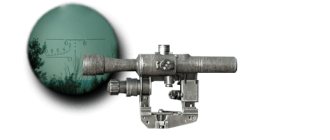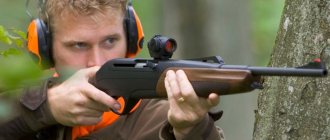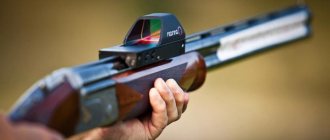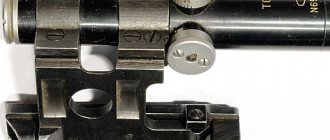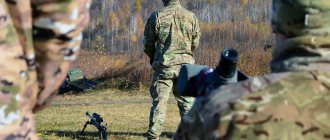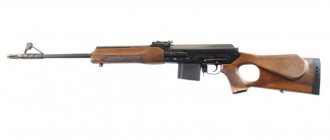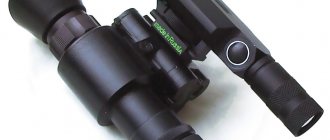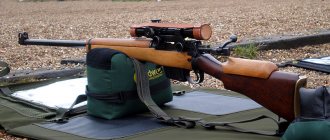An optical sight is an optical device consisting of a set of lenses combined in a special way, placed in a metal tube and designed to accurately aim a weapon at a target. An optical sight has long ceased to be a rarity; it is difficult to imagine a modern hunting rifle without an optical sight installed on it.
What types of optical sights are there? How to choose an optical sight? What parameters should you pay attention to when choosing? Let's look at these questions and answer them in detail.
Story
The predecessors of the optical sight are the telescope and spotting scope, which were invented in Holland at the beginning of the 17th century.
The world's first optical sight was invented in 1745 by Russian mechanical engineer A.K. Nartov, who was working at the Admiralty Department at that time. He called his invention “A mathematical instrument with a perspective telescope, with other accessories and a spirit level for quick guidance from a battery or from the ground at the shown location to the target horizontally and along the levation.”
Since the 1860s, rifle telescopes, as optical sights were called at that time, began to be widely used on hunting rifles. Optical sights were first used for military purposes in 1861-1865, during the American Civil War.
The modern type of optical sight as we know it today was created in 1880 in Austria-Hungary by August Fiedler.
The first variable magnification sight was created in 1949 by Frederic Kales. In 1972, she developed and patented multilayer coating for optics.
Optical sights are constantly being improved; more and more new materials and technologies are used in their design and production, new functions appear, and capabilities are expanded.
Optical sight device
Lens
The lens of an optical sight is a system of two or more lenses. The outer surface of the lens entrance lens most often has an anti-reflective coating, which prevents the back reflection of light and increases the aperture of the sight. The purpose of the lens is to collect as much light as possible and transmit it further.
Three parameters characterize the quality of the lens of an optical sight: the larger the diameter of the lens, the better the quality of the glass of the lenses and the better the quality of the anti-reflective coating of the lenses, the greater the aperture of the optical sight, the brighter its image, the better it is visible through the sight in the twilight, at night and when there is insufficient daylighting.
On some scopes, a light-protective hood or anti-reflective attachment is placed on the lens, which is sometimes necessary to prevent side rays from entering and then being reflected from the lens. The lens hood allows you to disguise the location of the shooter and improves image clarity in bright sunshine.
Wrapping system
The lens of an optical sight produces an inverted image; a wraparound lens system produces a correct, non-inverted image at the output. A high-quality sight uses more than 10 converging and diverging lenses, which are combined into groups.
The wrapping system is one of such groups. It is important that the lenses of the optical sight are securely fixed in the sight body and can withstand the recoil of weapons of any caliber.
Reticle
The aiming reticle is designed to aim the weapon at the target. The reticle can be located in one of the focal planes of the sight, objective or ocular. The reticle can have a different pattern, most often it has the shape of a cross or half-cross, but there are also more complex types. Some types of aiming reticles are designed in such a way that they allow you to calculate, with greater or less accuracy, the distance to the target based on its known dimensions.
Illuminated reticle
The reticle may be difficult to see in poor lighting conditions, at night, at dusk, or against dark vegetation. In order to solve this problem, a reticle illumination is built into the sight.
Mechanism for entering vertical and horizontal corrections
A mechanism for entering vertical and horizontal corrections is needed to zero the weapon and align the aiming reticle with the point of impact. The sight has two adjustment drums: one moves the reticle vertically, the second horizontally. The drums have a scale on them, and the drums rotate with clicks. The angle by which the reticle moves in one click is indicated in the technical specifications of the sight.
Sight body
Optical sight bodies are made of lightweight but very durable alloys. The body connects all components of the sight into a single structure.
The housing protects the internal parts of the sight from moisture and dust, and also protects them from powerful shock loads that occur during shooting.
Eyepiece
The eyepiece of an optical sight is a group of several lenses. It is the eyepiece of the optical sight that is responsible for magnifying the image of the target and the reticle. The focal length of optical sights designed for installation on rifles and carbines is usually 50-70 mm. This is exactly the distance from which you need to look through the scope in order for the image in the scope to be clear and not darkened at the edges. To adjust the sight to the shooter’s individual vision characteristics, there is a special rotating diopter ring on the eyepiece.
Some sights have a special rubber eyecup that fits over the eyepiece of the sight, which is needed in order to fix the eye in one position at the sight, as well as to avoid glare and flare on the eyepiece lens.
The device of the optical component of the sight
The optical sight contains a number of main components in its design, each of which determines the performance characteristics. Let's talk in more detail about the design of the optical sight.
Lens
A lens is an external lens aimed at an object. In modern models of sights, a system of a pair of lenses is placed, and other designs are less common. A lens with a set of lenses is called the first focal plane.
Lens parameters affect a number of optical characteristics of the sight:
- The front lens or optical design has a high focal length, this indicator determines the magnification of the sight.
- Lens size is a parameter indicated in the specification of an optical sight and affecting image quality. The wider the diameter of the lens, the greater the flow of light that penetrates the device, which means the image will be brighter and clearer. The viewing angle depends on the diameter of the lens.
- The outer lens may have an anti-reflective coating, which is often simply referred to as anti-reflective coating. A special layer with a yellow or blue-green tint applied to the surface of the lens allows light to pass into the device and does not allow it to be reflected in the opposite direction. As a result, the shooter receives a bright and clear image.
Wrapping system
The laws of optics are such that the image obtained using a biconvex lens or group of lenses is valid, but inverse. It is formed inside the focus of the sight at a short distance from the lens in the area of the first focal plane. An upside-down image creates inconvenience for the observer and significantly interferes with aiming and orientation in space.
The reversing system is designed to return the image to a straight position familiar to the observer. It is mounted in the central part of the sight and in modern models is equipped with four lenses connected in pairs. Although there are other designs.
Net
This is an image marking system designed to accurately aim a weapon at a target. It is a glass located between the lenses without optical properties. The glass is engraved in the form of a grid, or the markings are made by etching. For the same purposes, frames consisting of aiming threads are used. The intersection point of these threads indicates the position of the sight axis and the rifle barrel.
Depending on their location, the sighting reticles are combined into two groups:
- An objective reticle mounted in the first focal plane, that is, between the objective lenses. With this configuration, the grid is superimposed on the image and enlarged in proportions corresponding to the zoom factor.
- An eyepiece reticle located in the second focal plane in front of the eyepiece. As the image increases, the size of the reticle does not change. This option is considered the most convenient by hunters.
The pattern on the reticle is called a reticle. Although often this concept only includes a pointer pointing at a target. In addition to the pointer, other elements can be applied to the grid:
- Lateral correction scale.
- The main mark for shooting (square, cross, stump, etc.).
- Additional marks for vertical adjustments.
- Rangefinder scale for correlating the size of an object with human height - 1.7 meters, and determining the distance (more often found on military models).
Eyepiece
The eyepiece is the part of the sight that is close to the observer’s eye, and the shooter looks into it.
The eyepiece of the new sights is constructed of three lenses and its function is to magnify the image after its transformation by the wrapping system. This image is called the exit pupil, the main technical characteristics of which are:
- Eye relief is the distance from the eyepiece lens to the shooter's eye, at which the maximum space falls into the field of view while maintaining image quality. For hunting scopes, this distance is 7–11 cm. This is enough to avoid being hit by the eyepiece from recoil when firing.
- Exit pupil diameter is the size of the image, which should correspond to the size of the human pupil. This figure is 6 mm, but other values are possible. And the hunter’s pupil can change depending on the degree of lighting.
To correct the position of the lenses, the eyepiece of some sights is equipped with a diopter adjustment system. It allows you to compensate for the hunter’s vision and do without glasses when aiming.
Some scope models are equipped with a parallax adjustment function. If the observer's eye is moved away from the central axis of the sight, then the image shifts relative to the aiming marking, therefore, it affects the accuracy of aiming, especially at distances above 500 m. Lateral detuning has an advantage, since the hunter who is preparing to shoot does not need to change his position.
If we count the number of lenses in a sight of this design, we get the number nine. And this is no coincidence. It is this configuration that is closely related to the concept of aberration.
Spherical aberration is a physical process based on the characteristics of the refraction of solar rays of different colors. Rays passing through the side parts of the lens are refracted more strongly than those that fall closer to the central part. Therefore, all points of objects located at the edges of the image blur into spots. In this case, rays of different colors are refracted differently. Which gives, after repeated passage through the lens system, rainbow tints that intensify from the center to the periphery of the image. This effect is called chromatic aberration.
To compensate for spherical and chromatic aberration, lenses are made from high-quality glass of various types. The best results can be achieved when the scope is equipped with nine or more lenses.
Advantages of optical sights
- The optical sight increases the size of the target, which allows you to fire shots with high accuracy and at a long distance
- The target image and the aiming reticle are on the same plane, at the same distance from the eye, the shooter does not need to constantly refocus his gaze from the front sight to the target and back, which increases the convenience of aiming and reduces eye fatigue
- Many optical sights allow you to determine the angular dimensions of a target and calculate the distance to it
- The optical sight collects more light than the human eye, allowing you to see the target better in low light conditions
- Optical sights with an illuminated aiming reticle allow you to see it against a dark background, thereby making it possible to fire a shot in poor lighting conditions, up to almost complete darkness.
- The optical sight allows accurate shooting for people with visual impairments, including people with myopia, farsightedness and astigmatism, compensating them for their lack of vision
The device of a modern optical sight
- Lens. Includes two or more lenses, may have different coatings depending on the specifics.
- Image rotation system. Most often, this is a lens that sets the inverted image to be understandable on the ground.
- Sighting reticle. This is usually a guideline for precise aiming. Most convenient for the human eye, usually located inside the image rotation system.
- Eyepiece. This is a system of several lenses for an enlarged display of an image with all the constants. May have an eyecup made of soft materials and often includes a dioptre adjustment ring to suit the user.
- Editing mechanism. Allows you to make vertical and horizontal adjustments. It may have different design complexity to compensate for the possible drift of a bullet under the influence of various factors, the main one of which is wind.
- Backlight. Performed for sighting reticles in poor visibility conditions. Implemented only on the best and most expensive designs. It fully justifies its cost due to its increased practicality.
- Frame. Standard – sealed and shockproof. Allows you to support the entire structure in a single whole optical mechanism.
Disadvantages of optical sights
- The optical sight greatly reduces the field of view, thereby making it difficult to find a target and making it almost impossible to shoot at fast-moving targets
- The optical sight makes it very difficult to shoot at close range (20-30 meters), the target looks too big in the sight, blurry and shakes a lot, all this makes aiming much more difficult
- Trembling hands and movement of the chest when the shooter breathes can significantly complicate aiming with a weapon equipped with an optical sight.
Characteristics of optical sights
Objective lens entrance diameter
The diameter of the lens is one of the most important parameters of an optical sight, which affects the aperture ratio. The larger the diameter of the lens, the more light it collects, the greater the aperture of the scope, and the brighter and lighter the image produced by such a scope will be. The diameter of the lens will be especially important if the scope is used for hunting in low light conditions, at dusk or at night.
The choice of scope lens diameter depends on hunting conditions. For daytime hunting, a lens with a diameter of 40 mm is sufficient. For hunting at dusk, the best choice would be an optical sight with a lens diameter of 56 mm.
When choosing the lens diameter, it should be taken into account that as the lens diameter increases, the total weight of the sight also increases.
Lens quality and anti-reflective coatings
The image quality provided by a scope greatly depends on the quality of the glass lenses used in the scope and on the presence and quality of the anti-reflective coating on the lenses.
An objective lens with an anti-reflective coating applied to it transmits light much better, due to this the sight lens produces a more contrasting, bright and light image. From the outside of the lens, a lens that has an anti-reflection coating may appear orange, green, blue or purple, depending on the materials used to make the anti-reflective coating.
Anti-reflective coating on sight lenses can be of three types:
- C (Coated) - simple single-layer lens coating
- MC (Multi Coated) - multi-layer coating, but not on all lens surfaces
- FMC (Fully Multi-Coated) - multi-layer coating on all lens surfaces
Sights with FMC (Fully Multi-Coated) lenses provide a significantly brighter and more contrasty image compared to scopes with other types of lens coatings.
Increase
A group of lenses located in the eyepiece of the sight are responsible for magnifying the sight; they magnify and project the image onto the retina of the shooter’s eye.
Based on the type of magnification, all optical sights are divided into two groups: sights with constant magnification and sights with variable magnification.
Constant magnification sights
Sights with constant magnification have the following properties:
- All eyepiece lenses are rigidly fixed
- They have a higher aperture ratio because they have fewer lenses, so they give a brighter image
- They have greater reliability, since they have no moving elements
Variable sights
multiplicity
Sights with variable magnification have the following properties:
- Contains a movable lens in the eyepiece, with the help of which the magnification of the sight is adjusted
- They have a lower aperture ratio, since they contain a larger number of lenses, they give a darker image, in order to correct this shortcoming they have to use higher quality lenses
- Allows, along with changing the magnification, to change the angle of view of the sight
It is up to the hunter to decide which scope to choose with constant or variable magnification. If you know in advance exactly under what conditions and at what distance the shooting will be carried out, sights with constant magnification are preferable. If it is not known in advance under what conditions and at what distances the shooting will take place, then sights with variable magnification are preferable, since they are more universal.
- For shooting at short distances, at moving targets, for example during driven hunting, sights with a small magnification, no more than 1.5-2, are very convenient. They have a wide angle of view, thanks to which you can shoot with them even offhand, without careful aiming, with both eyes open.
- Sights with medium magnification are the most versatile and can be used for most types of hunting. The most versatile optical sights are those with variable magnification 3x–9x or 3x–12x.
- Sights with high magnification are designed for shooting at paper targets and for hunting at long and ultra-long distances. They have more weight, less aperture, and a small angle of view. They are used for special types of hunting; such sights cannot be considered universal. The most popular among them are scopes with variable magnification 6x–24x and 8x–32x.
Numbers in the name of the optical sight
Optical sights are usually marked in a special way. The scope is marked with two numbers separated by an “x”. For example: “Nikon Prostaff 4×32 optical sight.” The number 4 in the scope designation indicates the magnification of the scope, and the number 32 indicates the diameter of the objective lens entrance.
Sights with variable magnification are marked in a very similar way; first the magnification range is indicated, then the lens diameter. For example: “Leupold VXII 3-9×40 Riflescope,” which means a variable power scope with a magnification of 3x to 9x and a lens diameter of 40mm.
Exit pupil diameter
The diameter of the exit pupil is an important parameter of an optical sight, which indicates the size of the light beam emerging from the eyepiece. The larger the exit pupil diameter, the brighter and lighter the image produced by the scope. A large exit pupil diameter is especially important when hunting in low light conditions, twilight, at night, as well as when the shooter’s vision is imperfect.
In order to calculate the exit pupil diameter of a scope, you need to divide the lens diameter by the scope magnification, for example for a 4x32 scope, 32/4=8 mm.
The most optimal diameter of the sight's exit pupil is about 5 mm. The diameter of the exit pupil of the sight is more than 7-8 mm, larger than the diameter of the human pupil; there is no point in such a large diameter of the exit pupil.
Eye relief
The eye relief of an optical sight is the optimal distance between the sight eyepiece and the shooter's eye. For different optical sights, the eye relief can be from 40 to 105 mm. As this parameter increases, safety from recoil during a shot increases, but at the same time, along with an increase in eye relief, the convenience of aiming decreases.
The minimum allowable eye relief for the scope is 40 mm. When using a sight on a large-caliber rifled weapon - 60 mm, when using a sight on a smooth-bore weapon when shooting shotguns - at least 80 mm.
Sight field of view
When choosing an optical sight, you need to remember such a parameter as the field of view of the sight (Field Of View). The field of view of a sight is the width of the space viewed by the sight; it can be measured in degrees or in meters per 1 km. The greater the magnification (magnification) of the sight, the smaller the field of view.
This parameter is especially important when shooting at moving targets, when it is important that the target does not leave the field of view while aiming, therefore, when shooting at moving targets, the larger the field of view, the better. When shooting at stationary targets, this parameter does not play such an important role.
Optical sights
First sights
for weapons began to appear a very long time ago. Initially, firearms were equipped with a front sight. Subsequently, a rear sight appeared. At the beginning of the 17th century, front sights and rear sights (the so-called open mechanical sight) were already on almost all firearms. The simplest open sight consists of a transverse bar (shield, rear sight) mounted on the breech of the barrel. In the middle of the upper cut of the shield there is a slot through which they look at the front sight and aim the latter at the target. The aiming line is formed by connecting three points: the notch on the rear sight, the top of the front sight and the target itself. In some cases, the rear sight can be replaced by a disk with a hole - a diopter, and then such a sight will be called a diopter sight.
In the process of pointing a weapon at a target, the shooter simultaneously sees three points located at different distances from the eyes: the target, the front sight and the rear sight. Due to the peculiarities of the human eye, it can focus only on one of these points, while the others at this time will not be visible sharply enough. Typically, the shooter concentrates on seeing the weapon's sights sharply and clearly (a view of the front sight through the rear sight slot), while the distant target becomes somewhat blurry. Shifting your gaze and focusing your eye on another object takes some time.
The ability of the eye to clearly see distant objects and objects located nearby lies in a special property of the lens called accommodation. This property, however, does not allow one to simultaneously see sharply objects located at different distances; in the process of sighting, the gunner’s eye is forced to quickly and consistently adapt to seeing first one object, then another and a third. For shooters with well-trained and generally healthy vision, the process of accommodation occurs quickly and without significant effort by the lens muscles, while for others, three-point sighting is a rather complex action that causes visual fatigue. When shooting at moving targets, the time for aiming is extremely limited, so the number of aiming errors increases.
Marksmanship using mechanical sights is almost an art. To ensure accurate aiming, experienced shooters adjust the buttstock, train their eyesight, and regularly and repeatedly practice the aiming procedure. In any case, when shooting a rifle, a beginner must first learn to aim and shoot using a simple sight. And only when you achieve certain successes, in order to further improve your shooting performance and get the most out of your weapon, you can take on a more serious aiming technique.
With the advent of the first guns and to this day, many people continue to aim with the help of the most trivial devices - front sight and rear sight. Continue to use a primitive mechanical sight or install optics on your barrel - the choice is up to the owner of the weapon. In order for the choice of an aiming system to be informed, you need to know the advantages of optical sights and the parameters by which you need to choose an optical sight.
Optical sight
allows you to obtain an image of the object and the aiming reticle in the same plane with the same clarity.
Thus, in optical sights
, the shooter simultaneously sees the sighting device (the reticle or the so-called mark) and the image of the object (target), located in the same plane and at the same visible distance.
This is achieved by optically transferring the grid image to infinity. Thus, when using an optical sight
, the eye needs to accommodate one distance. This greatly simplifies the process of aiming the weapon and increases shooting accuracy compared to a mechanical sight.
A little history of optical sights
.
In 1604 F. Lipperstey and Z. Jansen designed a telescope, and in 1608 they tried to patent it (they were not given a patent for the invention, since the patent office responded that such a device was already known).
At this time, at the beginning of the 17th century, attempts were already being made to adapt the invented telescope to firearms.
The first real use of a telescope on a weapon was made by the Americans in the early 1800s. In particular, these ancient copper telescopes were installed on the famous muzzle-loading “Kentucky” rifles of the 1812 model, using black powder, and the shooting results (all 5 bullets from a distance of 165 m fit into a quadrangle with a side of 28 mm!) surpassed the “most magnificent” Russian rifle of our time with the best in world with an optical sight PSO-1 - SVD.
In 1850, I. Porro used “reversing” prisms on telescopes. Then the prismatic bent pipe was improved by the foreigner E. Abbe, and then by Zeiss in Germany.
In 1949, Frederic Kales invented an optical sight with variable magnification. In 1972, a foreign company patented multilayer coating of optics.
This optical sight concept is still used today. The figure below shows a typical diagram of a modern optical sight
1. Lens - a system of two (or more) lenses. The diameter of the lens determines the aperture ratio of the sight: the larger the diameter, the more light it collects and provides a better “picture” of the field of view.
2. Inverting system - serves to transform the inverted image created by the lens into a direct one.
3. Sighting reticle - the actual sight for aiming the weapon at the target. The aiming reticle is located in one of the focal planes of the sight (objective or ocular) and therefore the target image and the aiming reticle are visually in the same plane and are visible to the eye equally sharply. You can read more about aiming reticles at ((link)).
4. Eyepiece - a multi-lens design designed to view an enlarged direct image of the target and the aiming reticle. To avoid glare and flare of the eyepiece lens, as well as to accurately fix the eye in the full field of view of the sight, a rubber eyecup is often placed on the eyepiece.
5. Mechanism for entering vertical and horizontal corrections - used for zeroing the weapon and aligning the center of the aiming reticle with the point of impact of the bullet.
6. Illuminated reticle - installed in some sights so that the reticle does not merge with the visible image at dusk or against the background of vegetation. It is preferable to sights that have an adjustable backlight brightness so as not to obscure the target.
7. The sight body is made of durable light alloys and combines all the sight components into a single structure, which should ensure high resistance of the sight systems and mechanisms to the impact of shock loads arising during shooting.
The magnification (magnification) of optical sights ranges from 2X to 20X.
The distance from the sight to the eye on rifles with significant recoil is about 8 cm, on rifles with low recoil, such as cal. 5.6mm side fire can be reduced to 2-3 cm.
Sights (sighting reticle) of optical sights
At first they consisted of two thin threads crossing at right angles.
A single horizontal line with a "dot" (small ball) in the middle was then tested; after – a horizontal thread and an aiming pin with a pointed top; then - one hairpin; finally, thickened threads and a hairpin. The most convenient sighting reticle for shooting day and night is considered to be a vertical pin with a pointed apex and a horizontal thick line that turns into a thin line that is interrupted at the center. With the development of sights
, threads were no longer used; instead, their image began to be applied directly to the glass of the optical system.
Vertical installation in optical sights
(mechanism for entering corrections) was invented by the foreigner Feuchtländer, then the system was improved by K. Leiss, A. Preuss (). Old optical sights had only one permanent setting - in the form of a horizontal thread, corresponding to zeroing at 200 or 300m. Then, for the same purpose, they began to make 2,3, and 4 transverse threads, intended for distances of 100, 200m, etc.
Modern movable crosshairs, controlled by turning the handwheel, have settings from 100 to 1200m and much more in special optical sights for long-range, large-caliber sniper rifles invented abroad. Horizontal installation was not used in the first optical sights. By installing the scope on the rifle, we checked the battle by aiming through the telescope tube and moving the racks to the sides. As soon as the correct engagement was obtained, the telescope stands were firmly fixed at the most frequently used shooting distance. This position of the telescope remained unchanged.
Parallax
(Greek παραλλάξ, from παραλλαγή, 'displacement, alternation') is the apparent displacement of the observed object due to the movement of the shooter's eye in any direction. As a result of the apparent displacement of the aiming pin or crosshair, an error in aiming is obtained; this parallax error is the so-called parallax.
To avoid parallax
, when aiming through an optical sight, you should learn to always place your eye in the same position in relation to the eyepiece, which is achieved by good fit of the stock and frequent aiming exercises.
Good optical sights
allow you to move the eye along the optical axis of the eyepiece and away from it up to 4 mm without parallactic errors in aiming. For accurate shooting, it was necessary - but at the same time quite difficult - to be able to quickly find and maintain the desired eye position while aiming, exactly on the optical axis of the sight.
In modern sights, where the reticle is located in the rear focal plane (eyepiece), when the shooter's eye moves from the optical axis of the sight, there is no noticeable displacement of the reticle. But, surprisingly, they also have parallax and it is just as easy to see it, but it manifests itself in a completely different way - blurriness of the aiming reticle and the inability to see the image of the target and the aiming reticle simultaneously and with equal clarity, if the target is not at infinite distance -remote distance (usually in life shooting takes place at distances somewhat less than infinity). In order to simultaneously see the image of the target and the aiming reticle with equally high clarity at an infinitely distant (short) distance, you need to make adjustments to the settings of the optical system of the sight for each specific firing range, changing the interfocal distance of the lens and eyepiece.
There are two types of parallax adjustment devices - AO (Adjustable Objective) and SF (Side Focusing).
The first method (AO) is where the parallax adjustment ring is located directly on the scope lens (hence the name). This method is more common due to its simplicity and ease of implementation, or, more simply put, the slight increase in the cost of a sight with AO. But cheapness, as always, also has a downside - it is impossible to turn the parallax adjustment ring of the lens without changing the shooting position, which is not always convenient.
SF - the parallax adjustment mechanism is located on the side of the sight and is often equipped with a huge steering wheel, which serves for the convenience and smoothness of parallax adjustment without changing the posture and position of the shooter's head and body when aiming.
Modern optical sights have a caliper or a side dial (brackets for optical sights) for horizontal installations. Such devices were invented by foreign companies, Bush, Zeiss, etc.
The weight and dimensions of optical sights have remained virtually unchanged since the beginning of the 20th century. The weight of optical sights varies from 300 to 600g. The length of the sights is from 200 to 400mm.
Criteria for choosing optical sights
For the correct selection of optical sights
There are absolutely clear criteria. According to its purpose, the optical sight serves to clearly and clearly distinguish the target, determine the distance from the shooter to the target (if there is an optical measuring scale or laser for measuring the distance), mark impact points, change the magnification factor if necessary, aim the weapon at the target . In general, there are 4 criteria for choosing optical sights:
1.Optical and technical data
: weight; length; diameter of the central tube; diameter of the lens entrance hole; eyepiece exit diameter; optical zoom; field of view; correction introduced with one click of the adjustment mechanism at various distances; range of adjustment of the deflection of the line of sight to the side and in height; parallax.
2.Optical measurement data
(determined in laboratory conditions using special instruments): light transmittance, expressed as a percentage, during daytime and twilight visibility; distance of the eye from the eyepiece at min./max. increase; image contrast at min./max. increase; Average false light value in %, at min./max. increase.
3.Mechanical tests
: impact test to determine the deflection of the visor in height/to the side at a distance of 100 m; leak test; cold test at –20 degrees: speed of adjusting the visor in height and sides, speed of diopter adjustment, with a variable intermediate frequency - speed of magnification adjustment.
4.Optical sight control
: American design: sight in the eyepiece image plane; European design: sight in the lens image plane; adjustment of the visor: ease, convenience, accuracy and noiselessness, with or without tools; the zero position of the sight must be clear; the scale moves with a click (important for making adjustments in twilight and darkness); explication of the sight scale (especially important for police and military optical devices with flight path correction); presence or absence of parallax alignment; the presence of protective caps for the lens and eyepiece; availability of instructions for installation/assembly and maintenance; manufacturer's warranty.
When choosing an optical sight, you should immediately determine the scope of its tasks. For example, it is recommended to shoot using a scope with a magnification of more than 4x from a rest and, preferably, at stationary targets. Sights with a magnification of up to 4x are advisable to use for shooting at moving targets. When choosing an optical sight for installation on a pneumatic rifle, preference should be given to models with a large exit pupil (8 mm), which provides a greater range of displacement of the shooter’s eye, and at dusk, when the pupil of the eye increases to 8 mm, provides greater illumination in the eye and associated visual acuity. It is also worth considering that with strong recoil there is a risk of getting hit in the eye by the eyepiece of a telescopic sight.
When purchasing an optical sight, you should look through it at a distant object. The image must be of high quality, sharp, with good resolution of details within the entire field of view. If the scope has a variable magnification, you should make sure that when you change the magnification, the crosshair does not shift relative to the target and the sharpness of the target image is maintained. It is worth giving preference to proven products from well-known companies, since an optical sight is a complex multi-component optical device. Most of its parameters cannot be assessed without special equipment, in particular resistance to shock overloads when fired. When choosing an optical sight in a store, you should pay special attention to the absence of scratches and bubbles on the lenses, as well as dust and other foreign bodies inside the body of the sight.
You should also pay attention to the basic properties that a good optical sight should have:
- High light transmittance in the blue range of the spectrum (the image should not be yellow, since contrast suffers due to inaccurate color rendering).
- High image sharpness and contrast.
- Larger field of view possible.
- Large eye relief.
- Highly sealed housing, preventing the penetration of dust and moisture.
- Filling the scope cavity with nitrogen and protecting the internal surfaces of the lenses from fogging.
- High resistance of sight systems and mechanisms to shock loads during shooting.
- High accuracy and reliability of installation of lenses, sighting reticle and its adjustment mechanism, high accuracy and quality of manufacturing of mechanical elements (threaded connections, spring systems) and other control elements.
In our online weapons store you can buy optical sights from the world's leading manufacturers. Collimatron sights are especially popular.
Reticles
The reticle is located in the optical sight between the lens and the eyepiece, it is used to aim the sight at the target. To aim, you need to combine the target image with a certain part of the aiming reticle (crosshair, stump, corner).
The reticle is either a metal stencil or, most often, a lens with a reticle pattern applied to it. Part of the reticle may be a rangefinder scale, with which the shooter can calculate the distance to the target, knowing its dimensions.
Before firing from a weapon with an optical sight, the sight must be zeroed; for this, special handwheels are used to move the aiming reticle so that, at a certain distance, it coincides with the middle point of impact.
The reticle can be located on an optical sight in two planes: in the front focal plane (lens plane) designated FFP and in the rear focal plane (eyepiece plane) designated SFP.
If the reticle is located in the front focal plane (FFP), then the image on it itself will be inverted, but if the reticle is located in the rear focal plane (SFP), then the image on the reticle will be upright.
If a scope with a variable magnification has a reticle located in the front focal plane (FFP), then as the magnification increases, both the size of the target and the reticle itself increase.
For a scope with variable magnification with a reticle located in the rear focal plane (SFP), as magnification increases, the target image increases, but the size of the reticle and the thickness of its threads do not increase and remain the same.
There are many types of reticles. Most reticles are universal, suitable for shooting in different conditions, with different cartridges, at different distances. Some manufacturers of optical sights develop and produce their own specific sighting reticles, designed to fire certain cartridges, marked with impact points at different distances, such reticles are called ballistic.
Let's look at some of the most common sighting reticles.
Reticle "Cross" (Duplex)
The most famous and popular type of reticle. Such an aiming reticle allows you to aim the weapon with high accuracy, even at a small or very distant target. There are two varieties of this mesh: classic, the threads of which have the same thickness, and improved, the threads of which are narrower near the crosshair itself. The improved version of the grid is much more convenient. With this reticle, you can measure the distance to the target using the angular distance from the crosshair to the thickening of the sight threads.
Sighting reticle “Stump” (German)
This type of reticle was popular many years ago, but nowadays its popularity has decreased significantly. The main advantage of this reticle is the ability to quickly aim the weapon at the target. Using the distance between the side lines, you can measure the distance to the target, knowing its size.
Sighting reticle "PSO-1"
It was first used on the Soviet optical sight PSO-1, and is now still used on many optical sights of domestic production.
The PSO-1 mesh is intended for military purposes; it is not suitable for hunting purposes, although many hunters use it. This aiming reticle allows you to point the weapon at a small and/or distant stationary target with high accuracy.
The reticle has a ranging scale that allows you to quickly determine the distance to a standing person. Additional sighting angles allow you to shoot at different distances without having to readjust your sight.
Mil-Dot reticle
The most popular sighting reticle among those who like to shoot from a wide variety of weapons at long distances, it allows you to point the weapon with high accuracy at a small and distant stationary target.
The Mil-Dot reticle consists of two coordinate axes with equidistant marks. The angular distance between the grid points is 1 mil, the size of the dot itself is 0.25 mil, and the angular distance between the edges of two dots is 0.75 mil. Knowing these distances, the shooter can determine the distance to a target with known dimensions.
Ballistic reticles
A whole group of sighting reticles have several aiming points designed for firing a specific cartridge at various standard distances. There are ballistic reticles that have additional side marks designed to compensate for wind drift of the bullet. Sights with ballistic reticles give the shooter an advantage in accuracy and speed of aiming.
The shooter, when choosing the reticle of his optical sight, must take into account what weapon the sight will be installed on, under what conditions, at what distances and at what targets the shooting will be conducted. For most hunters, the most convenient reticle will be the “LR Duplex” type, which has a crosshair with thinning towards the center.
Illuminated reticle
When hunting in poor visibility conditions, at dusk, at night, against a background of vegetation, thin threads of the reticles become difficult to see for the shooter. To eliminate this drawback, manufacturers of optical sights produce sights with an illuminated reticle.
In old military sights, the illumination of the aiming reticle was done according to the principle of the spiral of an incandescent lamp; in the dark, when the illumination was turned on, it glowed orange. In modern optical sights, the illumination of the aiming reticle is based on LEDs, which are powered by a small coin cell battery.
Most often, the illumination of the sighting reticle is made in red or green, less often blue. Many modern sights have several backlight colors and you can select it yourself using a switch. It is highly desirable that the scope has an adjustable backlight brightness, otherwise, in some hunting conditions, too bright illumination of the reticle may illuminate the target and become an obstacle to making an accurate shot.
Parallax
The target image in an optical sight is projected by the lens onto the plane where the aiming reticle is located; parallax is the discrepancy between the target image plane and the plane of the aiming reticle.
Depending on which plane the reticle is in, the parallax in these two types of sights will look different. With a front focal plane (FFP) scope, when you move your eye to the left or right relative to the eyepiece, the target image appears to float relative to the center of the reticle and the aiming point moves away from the target. With a rear focal plane (SFP) sight, parallax appears a little differently; when the eye moves left to right relative to the eyepiece, the reticle is blurred and the shooter cannot clearly see both the reticle and the target at the same time.
Some scopes have a fixed parallax adjustment at a certain distance, made at the factory, without the ability to change it later. Other sights, more expensive, often with higher magnification, have a special mechanism for adjusting parallax depending on the shooting distance; for this, either the entire group of objective lenses or only the back part of the lenses, located closer to the aiming reticle, moves in the sight.
There are two parallax adjustment systems for optical sights:
- AO (Adjustable Objective)
- the parallax adjustment ring is located on the lens of the sight; the focusing distance scale in yards or meters is printed on the ring. This system is more common because it is simple and cheap. The disadvantage of such a system is the impossibility of adjusting parallax without looking away from the target. - SF (Side Focusing)
- a special regulator is located on the side of the sight; you can adjust the parallax without changing the position of the body and head and without looking up from the target.
Amendment mechanism
Any optical sight, after installing it on a weapon, requires zeroing. Zeroing the sight is necessary so that the center of the reticle coincides with the midpoint of impact. For this purpose, any sight has special handwheels, which are also called drums or turrets. One of the drums regulates the vertical movement of the sighting reticle, the other drum adjusts the horizontal movement of the sighting reticle.
Reels on optical sights can be of two types: hunting and tactical.
Hunting drum sights have a screw-on cover, under which the rotating drum itself is hidden. The cover is unscrewed only when the sight is zeroed; after the sight is zeroed, the lid is screwed on. During hunting, no adjustments are made to the sight.
Tactical drums are designed in such a way that they can be tightened at any time. Immediately before the shot, the shooter can make the necessary adjustments, depending on the distance of the shot, the speed and direction of the wind.
The optical sight correction mechanism must have the following mandatory qualities:
- The adjustment mechanism of the optical sight must have a large range of vertical adjustments; it must be at least 45-50 minutes of arc (MOA). This range of adjustments allows shooting at long distances.
- The adjustment mechanism of the optical sight must ensure strict perpendicularity of the settings, that is, when adjusting the sight vertically, there should be no deviation to the side.
- The mechanism of the optical sight must ensure repeatability of corrections, that is, when adjusting the correction drum in the forward and reverse directions by the same number of clicks, the reticle point of the sight must point to one point.
Gas filling
The housings of high-quality optical sights are completely sealed and filled from the inside with an inert gas, most often nitrogen. The lenses of the sight filled with nitrogen do not fog up due to temperature changes. This property of the scope is especially important when hunting in difficult weather conditions, with high humidity and low temperatures.
Installing a sight on a weapon
Many carbines and rifles have a ready-made Weaver/Picatinny rail, or dovetail mount, on the receiver. Other carbines and rifles have a mounting seat with threaded holes that accept either scope rings or a Weaver/Picatinny or dovetail adapter.
Scope rings can be of two types: with a diameter of 25.4 mm and 30 mm. The appropriate type of rings is selected depending on the diameter of the scope tube. The rings also vary in height. The height of the sight rings is selected depending on the diameter of the sight lens: the larger the lens diameter, the greater the height of the rings should be.
Rings can also be in the form of two separate rings, or in the form of a monoblock. It is recommended to install rings in the form of a monoblock on weapons with strong recoil.
Some examples of domestically produced hunting weapons with a military background may require the installation of a sight on the side, on a special bracket.
Disassembling the optical sight
Before disassembling the scope, make sure you have the necessary tools and “accessories.” You will need:
1. repair kit (set of flat screwdrivers);
2. inexpensive transparent sealant (solvent-free);
3. cotton swabs;
4. a clean cotton rag;
5. jars (for storing small bolts);
As an example, consider disassembling the VOMZ-P model. You will encounter the following configuration:
7. angular scale of lateral corrections;
8. lens wrapping system;
9. installation ring;
10. Aiming angle scale.
11. The lens is removed from the cassette (try not to touch the glass with your fingers).
First you have to unscrew the lenses (back/front). The adjusting drums are screwed in until they stop (clockwise), then unscrewed together with the pressure washers. Then the pressure and locking bolts are unscrewed one by one. Half of the pipe is unscrewed. The cassette containing the adjustment lens is carefully squeezed out.
The lens-turning system is localized in the remaining segment of the pipe. If desired, it is not difficult to unscrew it - the system is secured with one microbolt.
The structure is assembled in reverse order. Pay attention to the stained lenses - they should not be touched with your fingers. The lenses are wiped with one-sided movements (zero pressure).
Do-it-yourself scope repair - highlights
The time has come to study the mounting of the basic components of the optical sight. Please note that this is a fragile device, so you need to disassemble it with extreme caution. It starts to act up after about one and a half thousand shots. To prevent future problems, tighten the mounting screws and watch for horizontal alignment.
Attaching the sight lenses
Lenses for hunting weapons have a large diameter, designed for shooting at short distances (150-200 meters). Hunting optics have many rubbing surfaces that wear out over time. Backlashes, mechanical displacements and optical parallaxes occur.
Optical sight lens diagram
The lenses are attached using sealant. After disassembling the sight according to our instructions, you reach the ring nut that holds the crosspiece.
The further procedure is as follows: 1. squeezing out the cassette (do not lose the pressure spring); 2. unscrewing the front nut, lens and guide screws (2 pcs.); 3. removing the adjustment lenses from the inner cylinder (this must be done carefully, without giving the cylinder a vertical position); 4. remembering the location of the lenses; 5. repair.
If the tuning lens (usually the front one) has a loose locking ring, the threads will have to be lubricated with sealant. After waiting for it to dry, reassemble the entire structure in reverse order.
Sight pressure spring
During repair operations, you will inevitably encounter a pressure spring, which you need not only to preserve, but also to ensure its functionality.
A little advice: you can unscrew the nuts (if you don’t have a repair kit at hand) with pointed tweezers.
Loose screws and nuts (if they do not tighten well) should be placed on sealant. Now the repaired structure, together with the spring, must be pushed back into the pipe - this is a rather labor-intensive process. One end of the spring should end with teeth, the other should be completely smooth.
If necessary (presence of jags), the second end of the spring must be sanded. The spring is installed in the central part of the sight - between the holes intended for the adjustment drums. The tube slides onto the cassette with the assembled lenses, while the spring must be held through the holes.
Sight lubrication
Not all parts and components of an optical sight require lubrication. And even more precisely, only the rings need this. It is highly undesirable for grease to get on the surface of the lens.
For the lubrication procedure you will need: - alignment control rods; — abrasive lapping paste; — tools (torque screwdrivers, wrenches and levels); — thread locker.
Aluminum, steel and titanium rings are used to mount the sight. After lubricating them, install the scope so that the nuts are on the other side of the receiver port and bolt handle.
Repair of optical sight illumination
The basis for the illumination of the aiming reticle is an LED lamp. It is connected to the battery, but it receives energy not directly, but through a stabilizer. Repair activities need to begin with checking the stabilizer.
Having disassembled the microscopic power supply, take a closer look at the ballast resistor (capacitor). If the resistor burns out, it must be replaced. Sometimes the diodes in the rectifier burn out; they should also be checked. The third potential problem is low-impedance current limiting resistors.
If the LED is made in Asia, it means that a primitive Chinese capacitor has burned out. Replace it with a new one and live in peace.
Elimination of reticle displacement
Modern optics use a luminous aiming mark with brightness adjustment. The brand illumination should turn off automatically after a certain time. This saves battery power, as many shooters forget to turn off the battery.
In general, aiming marks are of the following types: - stump; - MilDot; — PSO-1; — Crosshair; - SVD
